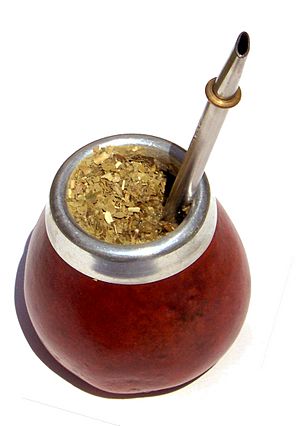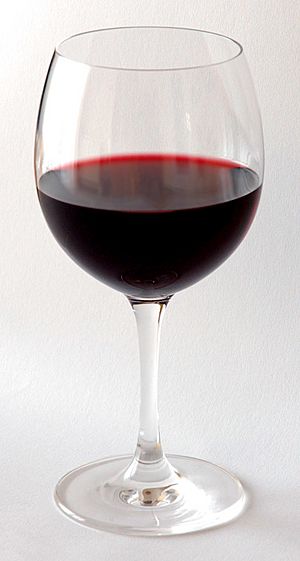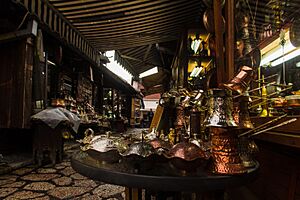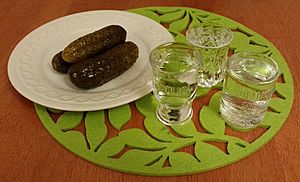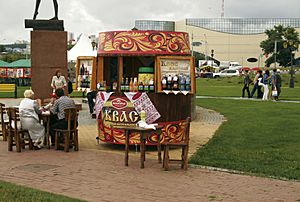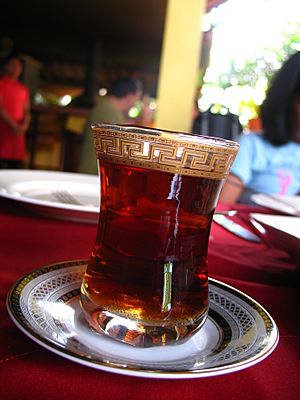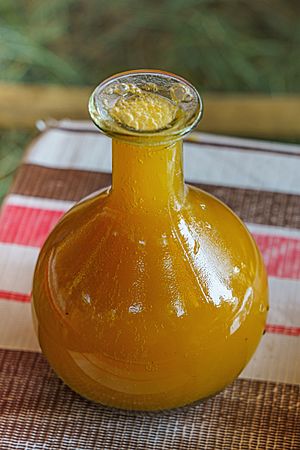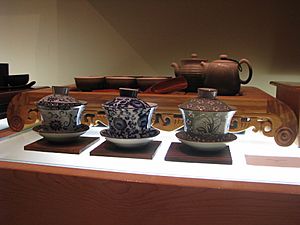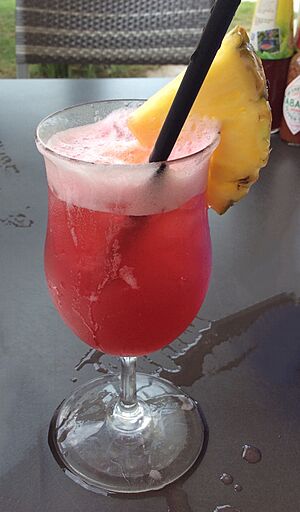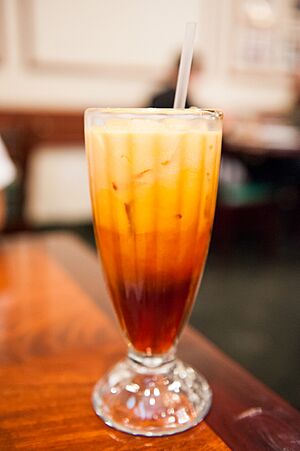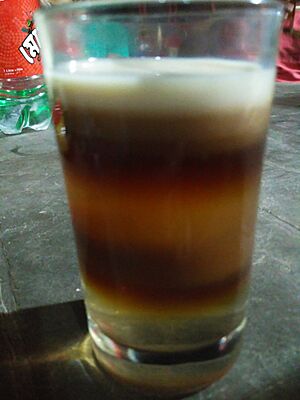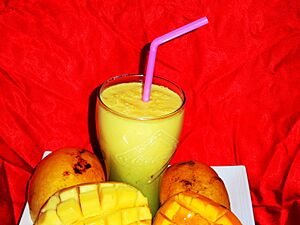List of national drinks facts for kids
A national drink is a special drink that is strongly linked to a certain country. It often shows what that country is all about and how its people see themselves. A drink can become a national drink for a few reasons:
- It's a common drink made from local ingredients. These ingredients are often prepared in a unique way. For example, mango lassi uses dahi, a traditional yogurt from India.
- It has a special ingredient that is only found in that country.
- It's served during celebrations and is part of the country's history and traditions.
- The country itself has officially said it is a national drink.
Sometimes, it's hard to pick just one national drink for a country. Big countries like Mexico, China, or India have many different cultures. This means they might have many popular drinks, not just one "national" one. Also, some drinks are national favorites in more than one country. For example, pisco sour is loved in both Peru and Chile.
The national drinks below are grouped by different regions of the world.
Contents
National Drinks Across the Continents
Drinks in America
North America's Favorite Sips
 Canada: The Caesar is a popular drink that started in Calgary. It's like a Bloody Mary but includes clam broth. People in Calgary even tried to make it Canada's official cocktail!
Canada: The Caesar is a popular drink that started in Calgary. It's like a Bloody Mary but includes clam broth. People in Calgary even tried to make it Canada's official cocktail! United States: Coffee became popular when Americans wanted an alternative to British tea. Coca-Cola is a famous soft drink, named after its original ingredients: coca leaves and kola nuts. Bourbon is a corn whiskey aged in special barrels. In 1964, it was named the U.S. National Spirit.
United States: Coffee became popular when Americans wanted an alternative to British tea. Coca-Cola is a famous soft drink, named after its original ingredients: coca leaves and kola nuts. Bourbon is a corn whiskey aged in special barrels. In 1964, it was named the U.S. National Spirit. Mexico: Tequila is a spirit made from the blue agave plant. It mostly comes from the area around Tequila city in Jalisco. Mexico even has a National Tequila Day every March! Other popular drinks include aguas frescas like Jamaica (hibiscus tea) and horchata. The Margarita is also a well-known drink.
Mexico: Tequila is a spirit made from the blue agave plant. It mostly comes from the area around Tequila city in Jalisco. Mexico even has a National Tequila Day every March! Other popular drinks include aguas frescas like Jamaica (hibiscus tea) and horchata. The Margarita is also a well-known drink.
Central and South America's Refreshments
 Antigua and Barbuda: Rum
Antigua and Barbuda: Rum Argentina: Mate is a tea-like drink made from yerba mate leaves. It's served hot with a metal straw and a hollow cup. Sharing mate is a big part of society in Argentina, Uruguay, and Paraguay. Fernet con cola (Fernet with cola) is also very popular, especially in Córdoba.
Argentina: Mate is a tea-like drink made from yerba mate leaves. It's served hot with a metal straw and a hollow cup. Sharing mate is a big part of society in Argentina, Uruguay, and Paraguay. Fernet con cola (Fernet with cola) is also very popular, especially in Córdoba. Bahamas: Switcha
Bahamas: Switcha Barbados: Mauby
Barbados: Mauby Belize: Rum Punch
Belize: Rum Punch Bermuda: Rum swizzle and Dark N' Stormy. The Dark N' Stormy must use Gosling's Dark Rum, which is made only in Bermuda.
Bermuda: Rum swizzle and Dark N' Stormy. The Dark N' Stormy must use Gosling's Dark Rum, which is made only in Bermuda. Bolivia (Plurinational State of): Chuflay and Singani.
Bolivia (Plurinational State of): Chuflay and Singani. Brazil: Caipirinha is a famous drink made with cachaça, lime, and sugar. Guaraná is a fizzy soft drink made from a fruit found in the Amazon.
Brazil: Caipirinha is a famous drink made with cachaça, lime, and sugar. Guaraná is a fizzy soft drink made from a fruit found in the Amazon. Curaçao: Curaçao liqueur is made from the dried peels of the Laraha, a bitter orange from Curaçao. It often has blue or orange colors added.
Curaçao: Curaçao liqueur is made from the dried peels of the Laraha, a bitter orange from Curaçao. It often has blue or orange colors added. Chile: Pisco sour.
Chile: Pisco sour. Colombia: Aguardiente and coffee.
Colombia: Aguardiente and coffee. Costa Rica: Imperial beer.
Costa Rica: Imperial beer. Cuba: Cuba Libre, Mojito, and Daiquiri.
Cuba: Cuba Libre, Mojito, and Daiquiri. Dominica: Mama Juana.
Dominica: Mama Juana. Dominican Republic: Mama Juana.
Dominican Republic: Mama Juana. Ecuador: Chicha.
Ecuador: Chicha. El Salvador: Pilsener and Champagne cola.
El Salvador: Pilsener and Champagne cola. Grenada: Rum Punch.
Grenada: Rum Punch. Guatemala: Gallo beer.
Guatemala: Gallo beer. Guyana: Mauby.
Guyana: Mauby. Haiti: Barbancourt is a rum made in Haiti from fresh sugar cane juice.
Haiti: Barbancourt is a rum made in Haiti from fresh sugar cane juice. Honduras: Pinol.
Honduras: Pinol. Jamaica: Rum Punch.
Jamaica: Rum Punch. Nicaragua: Macuá.
Nicaragua: Macuá. Panama: Seco Herrerano.
Panama: Seco Herrerano. Paraguay: Mate is a traditional tea-like drink. It is shared in a circle and is a key part of society.
Paraguay: Mate is a traditional tea-like drink. It is shared in a circle and is a key part of society. Peru: The Pisco sour gets its name from pisco, its main spirit. It also has sour citrus juice and a sweetener. The drink started in Pisco city. Inca Kola, a lemon-flavored soda, is also very popular.
Peru: The Pisco sour gets its name from pisco, its main spirit. It also has sour citrus juice and a sweetener. The drink started in Pisco city. Inca Kola, a lemon-flavored soda, is also very popular. Puerto Rico (US): Pina colada.
Puerto Rico (US): Pina colada. Saint Kitts and Nevis: Rum.
Saint Kitts and Nevis: Rum. Saint Lucia: Bounty brand Rum.
Saint Lucia: Bounty brand Rum. Saint Vincent and the Grenadines: Golden Apple Juice.
Saint Vincent and the Grenadines: Golden Apple Juice. Suriname: Kasiri.
Suriname: Kasiri. Trinidad and Tobago: Queen's Park Swizzle.
Trinidad and Tobago: Queen's Park Swizzle. Uruguay: Mate is a traditional tea-like drink. It is shared in a circle and is a key part of society.
Uruguay: Mate is a traditional tea-like drink. It is shared in a circle and is a key part of society. Venezuela (Bolivarian Republic of): Rum and tizana.
Venezuela (Bolivarian Republic of): Rum and tizana.
Drinks in Europe
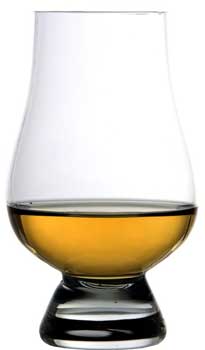
 Albania: Raki.
Albania: Raki. Andorra: Catalan Brandy and Wine.
Andorra: Catalan Brandy and Wine. Austria: Almdudler.
Austria: Almdudler. Belarus: Byarozavik is a traditional drink made from birch sap. It has become popular again recently.
Belarus: Byarozavik is a traditional drink made from birch sap. It has become popular again recently. Belgium: Belgium is famous for its many different beers and breweries.
Belgium: Belgium is famous for its many different beers and breweries. Bosnia and Herzegovina: Rakija and coffee.
Bosnia and Herzegovina: Rakija and coffee. Bulgaria: Bulgaria considers Rakia its national drink. It is a spirit made from fruits like plums and apricots.
Bulgaria: Bulgaria considers Rakia its national drink. It is a spirit made from fruits like plums and apricots. Croatia: Rakija and Pelinkovac.
Croatia: Rakija and Pelinkovac. Cyprus: Zivania and Brandy sour (unofficial).
Cyprus: Zivania and Brandy sour (unofficial). Czech Republic: Pilsner is a pale lager beer that started in Plzeň.
Czech Republic: Pilsner is a pale lager beer that started in Plzeň. Denmark: Akavit, Brännvin, Snaps, and Gammel Dansk.
Denmark: Akavit, Brännvin, Snaps, and Gammel Dansk. Estonia: Viru Valge, koduõlu (homemade beer), and kama.
Estonia: Viru Valge, koduõlu (homemade beer), and kama. Finland: Lonkero.
Finland: Lonkero. France: Red wine is made from dark grapes. Champagne is a well-known white wine from France.
France: Red wine is made from dark grapes. Champagne is a well-known white wine from France. Germany: Lager and Fanta.
Germany: Lager and Fanta. Georgia: Chacha and Red wine.
Georgia: Chacha and Red wine. Greece: Ouzo is a dry, anise-flavored drink. It is widely enjoyed in Greece and Cyprus.
Greece: Ouzo is a dry, anise-flavored drink. It is widely enjoyed in Greece and Cyprus. Hungary: Pálinka.
Hungary: Pálinka. Iceland: Brennivín and Appelsín.
Iceland: Brennivín and Appelsín. Ireland: Guinness is a dark Irish dry stout beer. Irish whiskey is also very popular.
Ireland: Guinness is a dark Irish dry stout beer. Irish whiskey is also very popular. Italy: Chinotto is a fizzy soft drink made from the myrtle-leaved orange tree fruit. Also popular are Wine, Spritz, Grappa, Espresso, and Cappuccino.
Italy: Chinotto is a fizzy soft drink made from the myrtle-leaved orange tree fruit. Also popular are Wine, Spritz, Grappa, Espresso, and Cappuccino. Kosovo: Rakia and Semoj, which is fermented cabbage juice.
Kosovo: Rakia and Semoj, which is fermented cabbage juice. Latvia: Riga Black Balsam.
Latvia: Riga Black Balsam. Liechtenstein: Blauburgunder.
Liechtenstein: Blauburgunder. Lithuania: Midus and Gira.
Lithuania: Midus and Gira. Luxembourg: Crémant de Luxembourg.
Luxembourg: Crémant de Luxembourg. Malta: Kinnie, Bajtra liqueur (unofficial), and Maltese falcon.
Malta: Kinnie, Bajtra liqueur (unofficial), and Maltese falcon. Moldova: Divin (Distilled Wine).
Moldova: Divin (Distilled Wine). Monaco: Champagne.
Monaco: Champagne. Montenegro: Rakija.
Montenegro: Rakija. Netherlands: Jenever.
Netherlands: Jenever. North Macedonia: Rakija and Boza.
North Macedonia: Rakija and Boza. Norway: Akvavit and Solo.
Norway: Akvavit and Solo. Poland: Vodka is considered Poland's national drink. It is made from grains or potatoes. Another popular drink is Krupnik.
Poland: Vodka is considered Poland's national drink. It is made from grains or potatoes. Another popular drink is Krupnik. Portugal: Port wine is a sweet fortified wine from the Douro Valley. It is often served as a dessert wine.
Portugal: Port wine is a sweet fortified wine from the Douro Valley. It is often served as a dessert wine. Romania: Țuică is a plum fruit brandy. It is often enjoyed before meals and at celebrations.
Romania: Țuică is a plum fruit brandy. It is often enjoyed before meals and at celebrations. Russia: Kvass is a traditional non-alcoholic drink often made from rye bread.
Russia: Kvass is a traditional non-alcoholic drink often made from rye bread. San Marino: Biancale.
San Marino: Biancale. Serbia: Rakija.
Serbia: Rakija. Slovakia: Borovička.
Slovakia: Borovička. Slovenia: Schnapps.
Slovenia: Schnapps. Spain: Sangria is a punch made with red wine and chopped fruit. It often includes orange juice or brandy.
Spain: Sangria is a punch made with red wine and chopped fruit. It often includes orange juice or brandy. Sweden: Brännvin, Punsch, and Akvavit.
Sweden: Brännvin, Punsch, and Akvavit. Switzerland: Rivella.
Switzerland: Rivella.
 Ukraine: Horilka and Kvass.
Ukraine: Horilka and Kvass. United Kingdom: Tea.
United Kingdom: Tea.
Drinks in Africa
 Algeria: Tea.
Algeria: Tea. Angola: Cuca Beer.
Angola: Cuca Beer. Benin: Sodabi.
Benin: Sodabi. Botswana: Chibuku Shake Shake is a traditional beer. Ginger beer is a favorite homemade non-alcoholic drink for special events.
Botswana: Chibuku Shake Shake is a traditional beer. Ginger beer is a favorite homemade non-alcoholic drink for special events. Burkina Faso: Zoomkoom.
Burkina Faso: Zoomkoom. Burundi: Sorghum beer.
Burundi: Sorghum beer. Cabo Verde: Grogue.
Cabo Verde: Grogue. Cameroon: Odontol.
Cameroon: Odontol. Central African Republic: Karkanji and Coffee.
Central African Republic: Karkanji and Coffee. Chad: Jus de Fruit and Tea.
Chad: Jus de Fruit and Tea. Comoros: Singani.
Comoros: Singani. Congo: Lotoko.
Congo: Lotoko. Côte d'Ivoire: Akpeteshie.
Côte d'Ivoire: Akpeteshie. Democratic Republic of the Congo: Lotoko.
Democratic Republic of the Congo: Lotoko. Djibouti: Kabisa (an energy drink). Djibouti has strict laws, so there isn't one main national drink.
Djibouti: Kabisa (an energy drink). Djibouti has strict laws, so there isn't one main national drink. Egypt: Black tea and Sugarcane juice.
Egypt: Black tea and Sugarcane juice. Equatorial Guinea: Malamba Juice.
Equatorial Guinea: Malamba Juice. Eritrea: Sawi, coffee, araki, and tea.
Eritrea: Sawi, coffee, araki, and tea. Ethiopia: Coffee and Tej.
Ethiopia: Coffee and Tej. Eswatini: Sibebe.
Eswatini: Sibebe. Gabon: Regab.
Gabon: Regab. Ghana: Akpeteshie (national spirit).
Ghana: Akpeteshie (national spirit). Guinea: Malamba Juice.
Guinea: Malamba Juice. Guinea-Bissau: Cana de Cajeu.
Guinea-Bissau: Cana de Cajeu. Kenya: Tea and Dawa cocktail.
Kenya: Tea and Dawa cocktail. Lesotho: Tholoana.
Lesotho: Tholoana. Liberia: Ginger beer.
Liberia: Ginger beer. Libya: Libyan tea and Arabic coffee.
Libya: Libyan tea and Arabic coffee. Madagascar: Rum.
Madagascar: Rum. Malawi: Thobwa.
Malawi: Thobwa. Mali: Green tea.
Mali: Green tea. Mauritania: Tea and Zrig (camel milk).
Mauritania: Tea and Zrig (camel milk). Mauritius: Alouda.
Mauritius: Alouda. Morocco: Moroccan mint tea (atai) is a green tea with spearmint leaves and sugar.
Morocco: Moroccan mint tea (atai) is a green tea with spearmint leaves and sugar. Mozambique: Tipo Tinto.
Mozambique: Tipo Tinto. Namibia: Oshikundu and Beer.
Namibia: Oshikundu and Beer. Niger: Biere Niger.
Niger: Biere Niger. Nigeria: Akpeteshie.
Nigeria: Akpeteshie. Rwanda: Ikigage, a sorghum beer.
Rwanda: Ikigage, a sorghum beer. São Tomé and Príncipe: Palm Wine.
São Tomé and Príncipe: Palm Wine. Senegal: Bissap.
Senegal: Bissap. Seychelles: Buka.
Seychelles: Buka. Sierra Leone: Poyo.
Sierra Leone: Poyo. Somalia: No official drink, but Shah hawaash (cardamom tea), coffee, and camel milk are popular.
Somalia: No official drink, but Shah hawaash (cardamom tea), coffee, and camel milk are popular. South Africa: No official drink, but Beer, Springbokkie, and Boeber are common.
South Africa: No official drink, but Beer, Springbokkie, and Boeber are common. South Sudan: Araqi.
South Sudan: Araqi. Sudan: No official drink, but Roselle tea, Araqi, Gongolez (baobab drink), Hulu-Murr (spiced sorghum beverage), and Aradaib (tamarind) are popular.
Sudan: No official drink, but Roselle tea, Araqi, Gongolez (baobab drink), Hulu-Murr (spiced sorghum beverage), and Aradaib (tamarind) are popular. Togo: Tchakpallo.
Togo: Tchakpallo. Tunisia: Tea.
Tunisia: Tea. Uganda: Waragi.
Uganda: Waragi. United Republic of Tanzania: Konyagi, tea, and coffee.
United Republic of Tanzania: Konyagi, tea, and coffee. Zambia: Munkoyo.
Zambia: Munkoyo. Zimbabwe: Chibuku.
Zimbabwe: Chibuku.
Drinks in Asia
East Asia's Unique Beverages
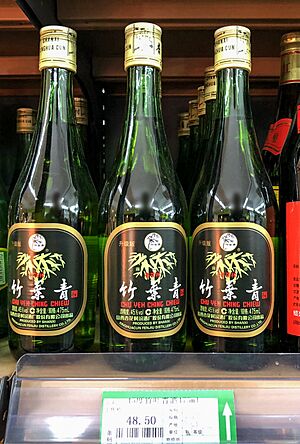
 China: Tea has been a huge part of Chinese culture for thousands of years. China has some of the oldest records of tea drinking. Chinese tea comes in many types, like white tea, yellow tea, green tea, oolong tea, black tea, and post-fermented tea.
China: Tea has been a huge part of Chinese culture for thousands of years. China has some of the oldest records of tea drinking. Chinese tea comes in many types, like white tea, yellow tea, green tea, oolong tea, black tea, and post-fermented tea.
- The Chinese national spirit, Baijiu, is an alcoholic drink made from grains like rice or wheat. It was first made 5,000 years ago!
 Hong Kong: Hong Kong-style milk tea.
Hong Kong: Hong Kong-style milk tea. Macau: Coffee (often with condensed milk) and tea.
Macau: Coffee (often with condensed milk) and tea. Taiwan: Bubble tea (also called pearl milk tea or boba) is a tea-based drink invented in Taiwan in the 1980s.
Taiwan: Bubble tea (also called pearl milk tea or boba) is a tea-based drink invented in Taiwan in the 1980s. Japan: Green Tea. Tea became popular in Japan around the 12th century. The Japanese tea ceremony is a very important part of Japanese culture.
Japan: Green Tea. Tea became popular in Japan around the 12th century. The Japanese tea ceremony is a very important part of Japanese culture.
 Mongolia: Airag or tsegee is a fermented milk product traditionally made from mare's (horse) milk. It is very important to people in Central Asia.
Mongolia: Airag or tsegee is a fermented milk product traditionally made from mare's (horse) milk. It is very important to people in Central Asia. North Korea: In 2019, Kim Jong-un named Pyongyang Soju as North Korea's national drink. Soju is a clear, colorless spirit from Korea.
North Korea: In 2019, Kim Jong-un named Pyongyang Soju as North Korea's national drink. Soju is a clear, colorless spirit from Korea. South Korea: Soju is a clear, colorless spirit from Korea. It is traditionally made from rice, but modern versions might use potatoes or sweet potatoes.
South Korea: Soju is a clear, colorless spirit from Korea. It is traditionally made from rice, but modern versions might use potatoes or sweet potatoes.
Southeast Asia's Refreshing Choices
 Brunei: No national drink, but Air Batu Campur (ABC) is popular.
Brunei: No national drink, but Air Batu Campur (ABC) is popular. Cambodia: Sombai infused rice wine.
Cambodia: Sombai infused rice wine. Indonesia: Es teler is a sweet iced drink. It was created in 1982 to be Indonesia's national drink.
Indonesia: Es teler is a sweet iced drink. It was created in 1982 to be Indonesia's national drink. Laos: Lao-Lao is a Laotian rice whisky. It is a main drink in Laos, along with Beerlao.
Laos: Lao-Lao is a Laotian rice whisky. It is a main drink in Laos, along with Beerlao. Malaysia: Teh tarik (meaning "pulled tea") is a hot milk tea drink. It's made by pouring the tea back and forth to create a frothy top. It is Malaysia's national drink.
Malaysia: Teh tarik (meaning "pulled tea") is a hot milk tea drink. It's made by pouring the tea back and forth to create a frothy top. It is Malaysia's national drink. Myanmar: Lahpet yay is made from fermented tea, sweetened condensed milk, and evaporated milk. It's often served hot in Burmese tea houses.
Myanmar: Lahpet yay is made from fermented tea, sweetened condensed milk, and evaporated milk. It's often served hot in Burmese tea houses. Philippines: San Miguel Beer.
Philippines: San Miguel Beer. Singapore: Kopi is a strong black coffee, often served with milk or sugar. It's a culturally important drink in Singapore.
Singapore: Kopi is a strong black coffee, often served with milk or sugar. It's a culturally important drink in Singapore.- The Singapore Sling is a gin-based drink created before 1915 at the Raffles Hotel. It is considered Singapore's national cocktail.
- Tiger Beer is seen as Singapore's national beer.
- The Milo dinosaur is a chocolate malt drink. It's a cup of iced Milo with extra Milo powder on top. It started in Singapore in the 1990s.
 Thailand: Thai tea is a Thai drink made from tea, milk, and sugar. It can be served hot or cold. Krating Daeng is an energy drink that inspired Red Bull.
Thailand: Thai tea is a Thai drink made from tea, milk, and sugar. It can be served hot or cold. Krating Daeng is an energy drink that inspired Red Bull. Timor-Leste: Cachaca.
Timor-Leste: Cachaca. Vietnam: Rượu nếp, Vietnamese rice wine, is made from fermented glutinous rice.
Vietnam: Rượu nếp, Vietnamese rice wine, is made from fermented glutinous rice.
South Asia's Beloved Beverages
 Bangladesh: Tea is considered Bangladesh's national drink. A new type of tea, the seven-layer tea, is also well-known. It has different layers of tea with different colors and tastes.
Bangladesh: Tea is considered Bangladesh's national drink. A new type of tea, the seven-layer tea, is also well-known. It has different layers of tea with different colors and tastes. Bhutan: Ara, or Arag, is a traditional alcoholic beverage. It is made from barley, rice, maize, millet, or wheat.
Bhutan: Ara, or Arag, is a traditional alcoholic beverage. It is made from barley, rice, maize, millet, or wheat. India: Tea is the most popular drink in India. Lassi or Chaas is a yogurt-based drink that can be sweet or salty. Masala chai is a hot, sweet tea with spices and milk. In southern India, Kaapi is a famous coffee drink.
India: Tea is the most popular drink in India. Lassi or Chaas is a yogurt-based drink that can be sweet or salty. Masala chai is a hot, sweet tea with spices and milk. In southern India, Kaapi is a famous coffee drink. Maldives: The Maldives has two main national drinks. First, sai (tea) is a favorite. Second, raa (palm wine tapped from palm trees) is also important.
Maldives: The Maldives has two main national drinks. First, sai (tea) is a favorite. Second, raa (palm wine tapped from palm trees) is also important. Nepal: Raksi is a strong, clear drink, like vodka. It is usually made from millet or rice. The Limbus people drink a lot of Tongba and raksi. For the Newars, aylaa is important during festivals.
Nepal: Raksi is a strong, clear drink, like vodka. It is usually made from millet or rice. The Limbus people drink a lot of Tongba and raksi. For the Newars, aylaa is important during festivals. Pakistan: Sugarcane juice and Chai.
Pakistan: Sugarcane juice and Chai. Sri Lanka: Tea.
Sri Lanka: Tea.
Central Asia's Traditional Drinks
 Afghanistan: No official drink, but tea and doogh are popular.
Afghanistan: No official drink, but tea and doogh are popular. Kazakhstan: Kumis, which is fermented horse milk.
Kazakhstan: Kumis, which is fermented horse milk. Kyrgyzstan: Maksym or jarma, both made from barley.
Kyrgyzstan: Maksym or jarma, both made from barley. Tajikistan: Green tea.
Tajikistan: Green tea. Turkmenistan: Chal.
Turkmenistan: Chal. Uzbekistan: Green tea.
Uzbekistan: Green tea.
West Asia's Refreshing Beverages
 Armenia: Oghi, Armenian wine, and Ararat (brandy).
Armenia: Oghi, Armenian wine, and Ararat (brandy). Azerbaijan: Black tea and Ayran.
Azerbaijan: Black tea and Ayran. Bahrain: coffee.
Bahrain: coffee. Georgia: Chacha and Red wine.
Georgia: Chacha and Red wine. Iraq: coffee, Arak, and Mint tea.
Iraq: coffee, Arak, and Mint tea. Iran: Doogh, a Persian yogurt drink, and Black tea.
Iran: Doogh, a Persian yogurt drink, and Black tea. Israel: Arak and Goldstar.
Israel: Arak and Goldstar. Jordan: Arabic coffee (served in small shots), Mint lemonade, and arak.
Jordan: Arabic coffee (served in small shots), Mint lemonade, and arak. Kuwait: Arabic coffee (kahwah).
Kuwait: Arabic coffee (kahwah). Lebanon: Arak.
Lebanon: Arak. Oman: Arabic coffee.
Oman: Arabic coffee. Palestine: coffee, Arak, and mint lemonade.
Palestine: coffee, Arak, and mint lemonade. Qatar: Arabic coffee.
Qatar: Arabic coffee. Saudi Arabia: Arabic coffee.
Saudi Arabia: Arabic coffee. Syria: coffee and Arak.
Syria: coffee and Arak. Turkey: raki; tea; and ayran (a non-alcoholic yogurt drink).
Turkey: raki; tea; and ayran (a non-alcoholic yogurt drink). United Arab Emirates: Arabic Coffee.
United Arab Emirates: Arabic Coffee. Yemen: Arabic Coffee, Qishr, and Naqe'e Al Zabib.
Yemen: Arabic Coffee, Qishr, and Naqe'e Al Zabib.
Drinks in Oceania
 American Samoa (US): Kava.
American Samoa (US): Kava. Australia: Lemon, lime, and bitters (LLB) is often called "Australia's national drink." It's a mix of lemonade, lime cordial, and bitters.
Australia: Lemon, lime, and bitters (LLB) is often called "Australia's national drink." It's a mix of lemonade, lime cordial, and bitters. Cook Islands: Tumunu.
Cook Islands: Tumunu. Easter Island: Easter Island Cocktail.
Easter Island: Easter Island Cocktail. Fiji: Most Fijians say Kava is their unofficial national drink. It's a welcome drink and important for social events. Kava is known for its calming effects.
Fiji: Most Fijians say Kava is their unofficial national drink. It's a welcome drink and important for social events. Kava is known for its calming effects. French Polynesia: Hinano Lager.
French Polynesia: Hinano Lager. Guam (US): Calamansi Basil Lemonade.
Guam (US): Calamansi Basil Lemonade. Hawaii (US): Mai tai.
Hawaii (US): Mai tai. Kiribati: Karewe is a palm wine made from coconut palm sap. It's a very important skill for young boys to learn how to collect it.
Kiribati: Karewe is a palm wine made from coconut palm sap. It's a very important skill for young boys to learn how to collect it. Marshall Islands: Coconut Water.
Marshall Islands: Coconut Water. Micronesia: Sakau.
Micronesia: Sakau. Nauru: Iced Coffee.
Nauru: Iced Coffee. New Caledonia: Wine.
New Caledonia: Wine. New Zealand: L&P.
New Zealand: L&P. Niue: Coconut Water.
Niue: Coconut Water. Northern Mariana Islands: Michelob Ultra.
Northern Mariana Islands: Michelob Ultra. Palau: Coconut Water.
Palau: Coconut Water. Papua New Guinea: Kava.
Papua New Guinea: Kava. Pitcairn Islands: Ti Punch.
Pitcairn Islands: Ti Punch. Samoa: Kava.
Samoa: Kava. Solomon Islands: Kava.
Solomon Islands: Kava. Tokelau: Kava.
Tokelau: Kava. Tonga: Kava is a very important drink in Tonga, often seen as their unofficial national drink. Only men usually drink kava, but a young woman called a touʻa serves it.
Tonga: Kava is a very important drink in Tonga, often seen as their unofficial national drink. Only men usually drink kava, but a young woman called a touʻa serves it. Tuvalu: Kava.
Tuvalu: Kava. Vanuatu: Kava drink.
Vanuatu: Kava drink. Wake Island: Beer.
Wake Island: Beer. Wallis and Futuna: Kava.
Wallis and Futuna: Kava.
Images for kids
-
Kaapi, Indian filter coffee.
-
Peach kompot, traditional to several countries in Eastern and Southeastern Europe.
-
Krupnik, a national drink of Poland.
-
Kvass, popular in the Baltic and Slavic countries.
-
Krating Daeng, an energy drink, created in Thailand.
-
The new Seven Color Tea, a recent competitor for national drink of Bangladesh.
-
Indian Masala chai served in a red clay tea cup.


